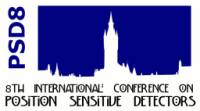Speaker
Dr
Freya Blekman
(Cornell University)
Description
The CMS Pixel Detector consists of three barrel layers closed by two forward/backward disks on each side of the interaction region, and provides a crucial contribution to pattern recognition, primary and secondary vertices reconstruction, as well as heavy flavour tagging. The sensors are n-on-n, with n+ implants on n bulk silicon, and a cell size of 100x150 um2. The Lorentz drift of electrons inside the magnetic field of 4 T leads to charge spreading of the order of 150 um for unirradiated sensors of 300 um thickness in the barrel, therefore the charge is collected typically on more than one pixel. In the forward disks charge sharing is obtained by tilting the sensors by 20 in a turbine-like geometry. A novel technique is presented for the reconstruction and simulation of pixel hits. The technique requires a priori knowledge of the track angle, which makes it suitable for the second pass in a two-pass reconstruction algorithm. It was originally developed to optimally estimate the coordinates of hits after the detector has been damaged by radiation, but it turns out to have superior performance also before irradiation.
Author
Dr
Freya Blekman
(Cornell University)

